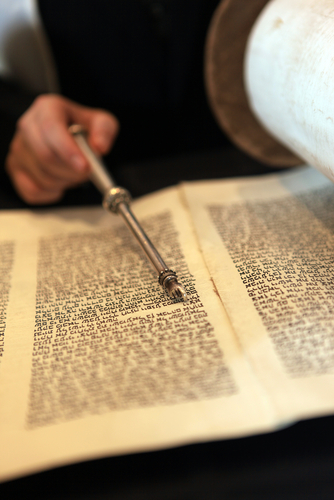Completing the Torah
 Patrick Wade of the Champaign News-Gazette had a fascinating story about the creation of a new Torah by hand. Here's how it begins:
Patrick Wade of the Champaign News-Gazette had a fascinating story about the creation of a new Torah by hand. Here's how it begins:
Crammed into an overflowing living room in the Chabad Center for Jewish Life on March 4, dozens of faithful onlookers suddenly fell into silent anticipation.
Rabbi Gad Sebag has been inking pages of parchment for about a year. There are 304,805 letters on a Torah scroll, each with its own unique curves and ornate accents. Tradition dictates how each letter is written, right down to the spacing and the all-natural ink itself.
Sebag has written nearly the whole thing with painstaking care. Now he's seated at the head of the crowd - in a house where there's only enough room for everyone else to stand - with the parchment unrolled in front of him. He's almost done, and a mistake here would be devastating.
For the last hundred letters or so, celebrants lined up to assist. They are all from different segments of the Jewish community - some from Champaign and Urbana and some students. Others have traveled farther distances from central Illinois. Some have come from the East Coast.
I'm always fascinated how so much of congregational life in the United States is not reflected in the news coverage. This is somewhat understandable, in that the day-to-day drama of a congregation isn't as exciting or as easy to report as some radical political move by a denomination's headquarters. But because we focus on the political and the dramatic, we miss some great stories at the local level.
So I just love that the reporter covered this. And it got wide play, which means that many people were interested as well.
The reader who sent it in spoke well of the story but had some quibbles as well:
I was struck by a few things in this story. First - what a great potential story! It *is* an accomplishment, and one that the public doesn't know much about. Which leads me to my second thought: is it just me, or does this story feel really incomplete? It doesn't really tell anything about Torah-making, or how rare it is, or whether it's a tradition shared broadly among Jewish sects, etc. It also doesn't really define what the Torah is or its place in Jewish culture/tradition.
I actually enjoyed the story a great deal but these criticisms are valid. Even in the excerpt above we're left wondering what, exactly, "different segments of the Jewish community" means. It's never really explained. A Chabad Center is mentioned again later, but is that the only portion of the community we're talking about?
The story is well written and evocative. He describes "an 'ayin,' a Hebrew letter that looks similar to an English 'y,' but with ornamental dollops of ink on top, like flames on candles." Nice, right?
Sebag, on the other hand, has inked millions of letters in 22 years. During the year he's been working on this scroll, he has replicated the story of the Jewish people from the creation of the world. He has been there while they were enslaved in Egypt, through the plagues and their escape. He has written through their wandering of the desert and when Moses was given the 10 commandments on Mount Sinai. Now he has taken them nearly to the border of the "Promised Land" of Israel.
The Torah is central to the Jewish faith, and Sebag's nearing completion of a new scroll is cause for great celebration. To the Jewish community in Champaign-Urbana, said Rabbi Dovid Tiechtel, it sends a message during a time of strife and concern. When it's completed, the new scroll itself will last 200 years or more.
This does assume that people know precisely what The Torah is, which may, sadly, be assuming too much. Still, it's a nice story and one that gets a great deal of information into a small space.
Torah image via Shutterstock.